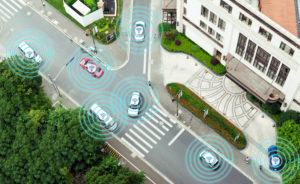Improvements in urban planning, health care, deliveries and insurance are a few of the areas beyond transportation where autonomous vehicles will bring benefits

Improvements in urban planning, health care, deliveries and insurance are a few of the areas beyond transportation where autonomous vehicles will bring benefits
The positive impacts of adopting autonomous vehicles will stretch beyond public transit and mobility, according to a study from the Autonomous Vehicle Innovation Network (AVIN).
The report, Autonomous Vehicles Reshaping the Future: Cross-Sector Opportunities and Considerations, was released on Oct. 4. It details possible changes to the urban planning, health-care, delivery, auto insurance, and media and advertising sectors.
Urban planning
As the types of vehicles on the road change, so does the nature of traffic. Since AVs will have the ability to drop off a passenger and go back to its place of origin, this will free up parking spaces for other vehicles like bicycles.
Freed-up parking capacity can be utilized for creating and expanding green areas and public plazas
Additionally, since the demand will be low, urban planners won’t need to factor in large-scale parking garages or spaces, as they won’t be needed. Instead, they will be able to focus their attention elsewhere.
“This freed-up parking capacity can be utilized for creating and expanding green areas and public plazas, building shopping and recreational centres, and for expanding housing development per the city’s needs,” says the report.
Health care
For the health-care industry, one of the most notable changes will be patient numbers.
“The most direct opportunity of AVs is that AVs are anticipated to greatly decrease injuries as a result of collisions, lowering the demand for related health care,” says the report.
Specifically, it’s anticipated if more vehicles are automated, there would be a 94 per cent decrease in vehicle-related injuries and death, as the “root cause” of these accidents is believed to be human error.
But the health-care industry won’t just benefit from having fewer patients, it will also help improve services for patients in other areas.
“With the adoption of AVs, the elderly, disabled, and non-driver patients can independently have access to convenient, always available, door-to-door means of transportation. For more convenience, care providers can partner with mobility as a service (MaaS) providers to automatically schedule autonomous rides for their patients based on their scheduled appointments,” says the report.
Additionally, it will also allow supplies to move more quickly between the suppliers and the institutions that need them.
Deliveries
The idea of humanless droids delivering packages isn’t new as Amazon in the U.S. and JD and Alibaba in China, among others, have invested in such technology. However, AVIN does note that droids of all shapes and sizes could soon be dropping off last-mile packages in Canada.

Not only will this make shipping more efficient, according the report, but will reduce costs somewhere between 10 and 40 per cent.
“This is mainly attributed to eliminating human labour, which will result in reducing shipping costs and expanding availability of delivery facilities for overnight and weekend pickups,” says the report.
This change also leaves auto companies with new business opportunities and partnerships. Recently, for example, Ford teamed up with Domino’s Pizza in 2017 and Walmart in 2018 to test automated delivery services.
Auto insurance
AVs may be automated, but they still need to be insured. In the report, AVIN outlines four areas cited by the Insurance Bureau of Canada that might look a bit different than current policies.
The nature of documents themselves will be one of the first changes, as the blame for accidents will shift from human error to the AV technology. And while AVs are expected to reduce the amount of accidents, with new technology comes new risks. Those highlighted in the report are cyberattacks and hardware malfunctions. However, information regarding data and the car itself will be more easily tracked, enabling insurance companies to better assess crash information and other data. This will then help them provide better prices for policies and claims, it says.

Due to these changes, the Insurance Bureau has proposed a three-point framework. The first is a single insurance policy for both automated cars and ones with drivers, while the second is to develop a data-sharing arrangement with car companies to better determine reasons for accidents. The last point is to create new vehicle safety standards that better address technology-related issues.
Media and advertising
Currently the most prominent type of media in vehicles is audio, due to radios and audio player hookups. This will change with AVs.
According to the report, videos and gaming will become more prominent in the form of video-on-demand services, mobile gaming, virtual reality and theatre-type setups, since the vehicles won’t need drivers.
Autonomous vehicles will change the way people work
The report also says AVs will also change the way people work, as passengers will be able to teleconference, e-mail and interact with clients and colleagues while in transit.
On the advertising side, AVs will be promotional tools.
“With the possibility of having multiple, big screens on-board, dynamic billboards can be brought to the vehicle compartment,” says the report. “This can be enhanced with an augmented and/or virtual reality experience, bringing the ability to discover the advertised product or service and make purchases while in transit.”






